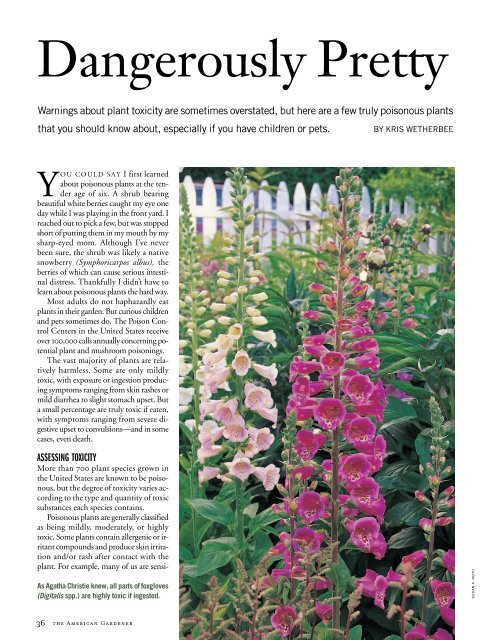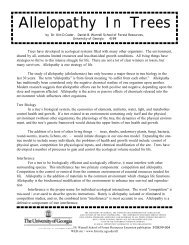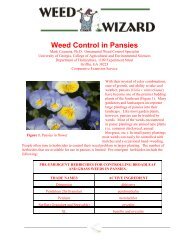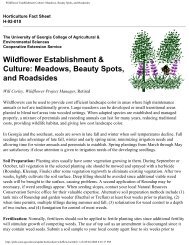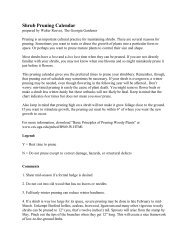Dangerously Pretty - Walter Reeves
Dangerously Pretty - Walter Reeves
Dangerously Pretty - Walter Reeves
- No tags were found...
Create successful ePaper yourself
Turn your PDF publications into a flip-book with our unique Google optimized e-Paper software.
<strong>Dangerously</strong> <strong>Pretty</strong>Warnings about plant toxicity are sometimes overstated, but here are a few truly poisonous plantsthat you should know about, especially if you have children or pets.BY KRIS WETHERBEEYOU COULD SAY I first learnedabout poisonous plants at the tenderage of six. A shrub bearingbeautiful white berries caught my eye oneday while I was playing in the front yard. Ireached out to pick a few, but was stoppedshort of putting them in my mouth by mysharp-eyed mom. Although I’ve neverbeen sure, the shrub was likely a nativesnowberry (Symphoricarpos albus), theberries of which can cause serious intestinaldistress. Thankfully I didn’t have tolearn about poisonous plants the hard way.Most adults do not haphazardly eatplants in their garden. But curious childrenand pets sometimes do. The Poison ControlCenters in the United States receiveover 100,000 calls annually concerning potentialplant and mushroom poisonings.The vast majority of plants are relativelyharmless. Some are only mildlytoxic, with exposure or ingestion producingsymptoms ranging from skin rashes ormild diarrhea to slight stomach upset. Buta small percentage are truly toxic if eaten,with symptoms ranging from severe digestiveupset to convulsions—and in somecases, even death.ASSESSING TOXICITYMore than 700 plant species grown inthe United States are known to be poisonous,but the degree of toxicity varies accordingto the type and quantity of toxicsubstances each species contains.Poisonous plants are generally classifiedas being mildly, moderately, or highlytoxic. Some plants contain allergenic or irritantcompounds and produce skin irritationand/or rash after contact with theplant. For example, many of us are sensi-As Agatha Christie knew, all parts of foxgloves(Digitalis spp.) are highly toxic if ingested.SUSAN A. ROTH36 the American Gardener
Calla lilies, left, and elephant’s ears and caladiums, right, contain calcium oxalate. If ingested, these microscopic needlelike crystalscan irritate sensitive tissue in the mouth and throat. Contact with the plant sap can cause skin irritation.TOP: DAVID CAVAGNARO (2). BOTTOM: BETSY STRAUCHtive to poison oak or poison ivy to varyingdegrees, but some people also react to boxwood(Buxus spp.) or chrysanthemums(Chrysanthemum spp.) with mild dermatitis.And while poinsettias are not poisonous,if you have a sensitivity to latex,contact with them can result in a skin rash.In addition, there are photosensitizingcompounds possessed by plants such asmarigold (Tagetes spp.) and yarrow (Achilleamillefolium and hybrids) that make theskin more sensitive to the sun.The potential for problems increaseswhen a poisonous plant is ingested. At the“mild” end of the scale are plants that typicallyproduce localized mouth or throatpain, or limited digestive distress. Callalilies (Zantedeschia spp.), caladiums, andelephant’s ear (Colocasia esculenta) containcalcium oxalate crystals that can piercecell walls in the mouth and throat causingserious pain and swelling. Elephant’sear—also known as taro or dasheen—is acurious case, however, because its tuberousroots and young leaves are staple fooditems in many tropical regions. Apparentlythe cooking process breaks down thepoisonous compounds.Many other plants cause nausea, vomiting,and/or diarrhea if they are ingested.Common examples include holly (Ilexspp.), four-o-clock (Mirabilis jalapa), andsoapwort (Saponaria officinalis).The amount ingested influences theseverity of symptoms. For instance, daffodilsand dahlias are toxic only if consumedin large quantities. Highly toxicplants, however, cause a host of debilitatingsymptoms even in small doses. Azaleasand rhododendrons contain a toxic compoundcalled andromedotoxin, a hydrocarbonpresent in many conifers andChildren should be warned to steer clear ofthe attractive orange to red fruits of daphnes,which contain poisonous glycosides.plants in the heath family (Ericaceae) thatcan cause a variety of symptoms—themost extreme being paralysis or coma.Plants with berries containing certain glycosidesor alkaloids—such as deadlynightshade (Atropa belladonna), privet(Ligustrum spp.) or daphnes—may evenprove fatal if eaten.“The true toxicity depends on whatbody tissue they impact,” says Sharon M.Douglas, a plant pathologist with the ConnecticutAgricultural Experiment Station.Different plant toxins may affect the spinalcord, brain, heart, liver, kidneys, or nervoussystem. “The level of a particular toxiccompound may also be quite variablewithin a plant or plant family,” Douglasadds. Take the nightshade family (Solanaceae),for example. Tomato fruits are nontoxic,and potato tubers are a culinarystaple, but the leaves, vines, sprouts, andgreen berries are highly toxic and may evenbe fatal. All parts of deadly nightshade arehighly toxic.FACTORING IN THE VARIABLESAs potatoes demonstrate, one part of aplant may be edible, while other parts aretoxic. Rhubarb is another classic example—thestems are edible but the leavesare highly poisonous. The fruits of apricot,peach, nectarine, and cherry are absolutelydelicious, but the seeds, twigs,November / December 200637
TRULY TOXIC GARDEN PLANTSPoisonous plants can vary in their toxicity and the type of reaction they produce. The truly toxic cause seriousproblems—even death—if ingested. Take special note of the following common garden plants.CASTOR BEAN (Ricinus communis)Annual with large, attractive leaves growing six to 15 feettall. Ornamental fruit capsule is large, prickly, and brightred and contains beanlike seeds.Poisonous parts: Seedsare highly toxic if ingested,leaves to a lesserextent.Toxic principle: Containsricin, a highlytoxic protein, and ricinine,an alkaloid.Symptoms: Nausea,vomiting, abdominalpain, bloody diarrhea,convulsions, coma; alsogastrointestinal, kidneyand liver damage; canbe fatal. Contact withbroken seeds may producesevere dermatitis in some individuals.Comments: Carefully store seeds prior to planting; cut offflower stalks before they set seed.DAPHNE (Daphne spp.)Evergreen, semievergreen,or deciduousshrubs with clusters oftypically fragrant flowersfollowed by red or yellowfruit.Poisonous parts: Allparts are poisonous,especially fruits.Toxic principle: Diterpenoid(mezerein).Symptoms: Swelling and ulceration of mucous membranesin mouth, throat, and stomach; nausea, vomiting, internalbleeding, kidney damage, coma, may be fatal; leaves containirritant chemicals that may cause burning or blisterson exposed skin; ingesting berries can be fatal.Comments: All Daphne species are toxic, particularly D.cneorum, D. genkwa, D. gnidium, D. laureola, D. mezereum,and D. odora.DATURA, JIMSON WEED,COMMON THORNAPPLE (Datura spp.)Nightshade family annuals with erect, funnel-shaped flowersfollowed by spiny fruit capsules containing manyseeds. Angel’s trumpet (Brugmansia spp.), a closelyrelated and similarly toxic tropical species, has droopingflowers and fleshy fruit.Poisonous parts: All parts are highly toxic.Toxic principle: Tropane alkaloids.Symptoms: Hallucinations, headache, delirium, rapid andweak pulse, convulsions, coma; can be fatal.Comments: Cut off spent flowers to prevent formation ofseeds, which are particularly toxic.DELPHINIUM, LARKSPUR (Delphinium spp.)Annuals, biennials, or perennials with upright spikes ofelongated flower clusters growing three to seven feet tall;smaller species grow to 12 inches tall.Poisonous parts: All parts, especially young plants andseeds.Toxic principle: Potent alkaloids, including delphinine andajacine.Symptoms: Burning and numbness of mouth and throat,intense vomiting and diarrhea, muscular weakness andspasms, respiratory system paralysis, convulsions; can befatal.Comments: Most species are also poisonous to cattle.FOXGLOVE (Digitalis spp.)Biennial or short-lived perennial with showy tubular flowerson elongated spikes growing two to eight feet in height.Poisonous parts: All parts, including water from vasescontaining cut flowers.Toxic principle: Cardiac or steroid glycosides.Symptoms: Nausea, vomiting, diarrhea, stomach pain,severe headache, dangerously irregular heartbeat, mentalconfusion, tremors, convulsions; can be fatal.Comments: Source of pharmaceutical digitalis, a potentheart medication.LILY-OF-THE-VALLEY (Convallaria majalis)Creeping perennialgroundcover to nineinches tall, with whiteor pale pink sweetscented,bell-shapedflowers, sometimesfollowed by bright redberries in fall.Poisonous parts: Allparts, including water38 the American Gardener
from vases containing cut flowers.Toxic principle: Cardiac glycosides and saponins.Symptoms: Irregular heartbeat and pulse, abdominal pain,diarrhea, mental confusion.Comments: Contains cardioactive toxins similar to those infoxglove; glycoside compounds are a source of pharmaceuticalheart medications.MONKSHOOD (Aconitum spp.)Perennial or biennial with showy hooded blue, purple, oryellow flowers that rise above handsome clumps of lobedor deeply cut leaves; plants are two to six feet tall.Poisonous parts: All parts.Toxic principle: Potent alkaloids, including aconitine.Symptoms: Burning of mouth and numbness of throat;paralysis of the respiratory system; nausea, vomiting;muscular weakness and spasms; convulsions; can be fatal.Comments: Avoid planting near vegetables which produceedible underground crops to avoid accidental harvesting ofthe toxic tuberous root.OLEANDER (Nerium oleander)Ornamental evergreenshrubs or small treeswith leathery leavesand funnel-shaped,typically fragrant flowersclustered at tip oftwigs or branches.Poisonous parts: Allparts are extremelytoxic, green or dry,including smoke fromburning branches orwater from vases containing cut flowers.Toxic principle: Cardiac glycosides, saponins.Symptoms: Nausea, vomiting, stomach pain, diarrhea,dizziness, irregular heartbeat; can be fatal.Comments: Do not use the stems or branches as skewers forfood; a single leaf may be highly toxic if ingested.PIERIS (Pieris spp.)Attractive evergreen shrubswith drooping clusters ofwhite, pink, or reddish urnshapedflowers.Poisonous parts: Leaves andnectar from flowers.Toxic principle: Andromedotoxin.Symptoms: Nausea, vomiting,diarrhea, hypersalivation,abdominal pain, weakness, convulsions, coma,cardiovascular collapse; can be fatal.Comments: Andromedotoxin is a neurotoxin also found inthe nectar of certain species of rhododendron (Rhododendronspp.) and other members of the heath family.WISTERIA (Wisteria spp.)Twining, woody vines with pealike flowers born onelongated, pendent clusters of blue, white, or pinkblooms followed by velvety,pealike pods.Poisonous parts: Seeds (mosttoxic), pods, and bark.Toxic principle: Glycosidewisterin and a toxic resin.Symptoms: Severe digestivedisorders; nausea, vomiting,stomach pain, diarrhea,dehydration.Comments: Though no fatalitieshave been reported, theseeds can seriously poisona child.YEW(Taxus spp.)Evergreen, coneless shrubs or trees are dioecious (maleand female flowers on separate plants), with femalesproducing red, fleshy berrylike fruits—each containinga single green seed.Poisonous parts: Bark, leaves, seeds.Toxic principle: Alkaloid taxine, a cardiac depressant.Symptoms: Nervousness, trembling, slow heart rate andpulse, breathing difficulties, abdominal pain, vomiting,convulsions, cardiacfailure; cancause suddendeath.Comments: Thered, fleshy partsurrounding theseed (called thearil) is sweet andedible, thoughthe single seed itcontains is highlytoxic, along withthe rest of theplant.Photos: Opposite page, top left and bottom right: David Cavagnaro; bottom left: Mark Turner. This page, topleft: Saxon Holt; bottom left: Jerry Pavia; top right: Susan A. Roth; bottom right: David CavagnaroNovember / December 200639
ResourcesThe AMA Handbook of Poisonous and Injurious Plants by Kenneth Lampe, MaryAnn McCann, and American Medical Association. American Medical Association,Chicago, Illinois, 1985.Animal Poison Control Center, (888) 426-4435. www.aspca.org/apcc. Note: Aconsultation fee may be charged.Canadian Poisonous Plants Information System, http://sis.agr.gc.ca/pls/pp/poison.Common Poisonous Plants and Mushrooms of North America by Nancy J. Turnerand Adam F. Szczawinski. Timber Press, Portland, Oregon, 1995.Cornell University Poisonous Plants Database, www.ansci.cornell.edu/plants.Handbook of Poisonous and Injurious Plants by Lewis S. Nelson, Richard Shih,and Michael Balick. Springer Publishing, New York, New York, 2006.National Capital Poison Center, (800) 222-1222. www.poison.org.Poisonous Plants of the United States by <strong>Walter</strong> Conrad Muenscher. MacmillanPublishing, New York, 1972.Children should be warned about all toxicplants, particularly those such as rhubarb,shown here, which have edible stems butpoisonous leaves.and foliage contain varying levels ofcyanogenic glycoside, a highly toxic compoundthat can produce cyanide whenplant cells are damaged. Be forewarned:don’t use any branches or twigs of thesetrees as kebab skewers or roasting sticks.The plant species, condition of theplant, stage of its growth, and the environmentall play a part in the levels of toxinspresent within plants. Other variables caninfluence the degree of reaction and severityof symptoms, such as a person’s healthstatus, age, and weight in relation to howmuch is ingested. Small children are particularlyat risk because they have a lowerbody mass than adults and can be affectedby smaller doses of toxins. Individual reactioncan also vary according to a person’sdiet, metabolism, and medications.Regional Poison Center. “[Calls about] indoorplants are far more common, by a 3to 1 ratio.” If you’re unsure as to the identityof a particular plant, bring a sample toyour local nursery or county Extensionagent for proper identification.Be sure to educate everyone in yourfamily about the potential dangers of plantpoisonings. Teach kids to take a “handsoff” approach to plants that have the potentialfor contact dermatitis. Never useany plant parts for any food purposes unlessyou are absolutely sure they are safe.Young children especially should be taughtnever to eat any outside or inside plant—fruit, leaves, stems, seeds, flowers, or otherwise—withoutasking first. (Plantscomprise 6.9 percent of poison exposureAVOIDING DANGEROne of the most effective ways you canavoid the hazards of plant poisoning is toidentify your plants both indoors and outdoorsand learn their toxic potential beforea poisoning occurs. Indoor plants that arewithin reach of children can be particularlyhazardous. “We receive about 1,600 to1,700 calls about plant ingestion per year,”says Henry Spiller, director of Kentucky’sDumb cane (Dieffenbachia spp.), left, and lilies, right, are among the common indoor plantsthat are often implicated in poisonings of pets.MICHAEL S. THOMPSON (3)40 the American Gardener


